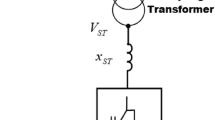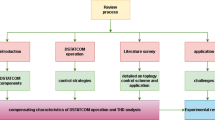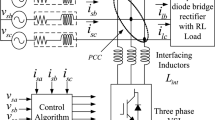Abstract
The location of a fault on a multi-terminal transmission line is necessary for restoring the network as quickly as possible to maintain reliable power supply. Phasors-based fault locators are well-established approaches in conventional algorithms and face complexity in locating faults at far-end cases and between tapped points. Due to non-availability of information between tapped points, the reliability of fault locator schemes may provide erroneous computations. This paper concentrates on developing a reliable approach to obtain accurate fault locations and identifies the exact faults that occur in terminal line or between the tapped points on multi-terminal transmission lines using the discrete wavelet transform (DWT). Due to its reduced computing overhead and elimination of the expeditious Fourier transform’s disadvantages, the DWT is well suited for practical use (FFT). The arrival periods of the succeeding peak waves produced by the fault are determined using the travelling wave theory, and these findings are subsequently employed to accurately determine the fault location. The technique performance is elucidated using MATLAB/SIMULINK environment by considering standard transmission lines of four terminals, five terminals and six terminals, respectively. The numerical results produced under various fault situations by different fault types, fault resistance and fault initiation angles to confirm the efficacy of the proposed method. The method performance is also validated on renewable integrated transmission network and results showcase the proposed method is immune to any configuration of a power system.




















Similar content being viewed by others
Data availability
Not applicable.
Code availability
Not applicable.
References
A.T. Johns, S. Jamali, Accurate Fault Location Technique for Power Transmission Lines, in IEE Proceedings C, Vol. 137(1990)
J. Izykowski, E. Rosolowski, P. Balcerek, M. Fulczyk, M.M. Saha, Accurate non iterative fault location algoriyhm utilising two-end unsynchronized measurements. IEEE Trans. Power Del. 26(2), 547–555 (2011)
R.K. Agarwal, D.V. Coury, A.T. Johns, A. Kalam, A practical approach to accurate fault location on extra high voltage teed feeders. IEEE Trans. Power Del. 8(3), 874–883 (1993)
A. Girgis, D. Hart, W. Peterson, A new fault location technique for two and three terminal lines. IEEE Trans. Power del. 7(1), 98–107 (1992)
C. Yu, C.Liu, Y. Lin, A fault location algorithm for transmission lines with tapped leg—PMU based approach, in 2001 power engineering society summer meeting. Conference proceedings, vol. 2 (2001) pp. 915-920
M. Abe, T. Emura, N. Otsuzuki, M. Takeuchi, Development of a new fault location system for multi-terminal single transmission lines. IEEE Trans. Power Del. 10(1), 159–1687 (1995)
S.M. Brahma, Fault Location Scheme for a Multi-Terminal Transmission Line Using Synchronized Voltage Measurements. IEEE Trans. Power Del. 20(2), 1325–1331 (2005)
S.M. Brahma, New Fault Location Method for a single Multi-Terminal Transmission Line Using Synchronized Phasor Measurements. IEEE Trans. Power Del. 21(3), 1148–1153 (2006)
G. Manassero, E.C. Singer, R.M. Nakagoni, E.L. Pellini, E.C.N. Rodrigues, Fault-location sysytem for multiterminal transmission lines. IEEE Trans. Power Del. 21(3), 1148–1153 (2006)
B.R.K. Varma, P.R. Rao, A hybrid method for fault location in ehv multi-terminal circuits, in16th national power systems conference 2010 Dec (2010)
E.E. Ngu, K. Ramar, A combined impedance and traveling wave based fault location method for multi-terminal transmission lines. Electr. Power Energy Syst. 33, 1767–1775 (2011)
F.H. Magnago, A. Abur, Fault location using wavelets. IEEE Trans. Power Del. 13(4), 1475–1480 (1999)
C.Y. Evrenosoglu, A. Abur, Travelling wave based fault location for teed circuits. IEEE Trans. Power Del. 20(2), 1115–1121 (2005)
K. Andanapalli, B.R.K. Varma, Travelling wave based fault location for teed circuits using unsynchronised measurements, in 2013 international conference on power, energy and control (ICPEC), (2013) pp. 227–232
S.R. Punam, A.V. Satpute, Review multiterminal transmission lines protection techniques. Int. J. Eng. Res. Technol. 4(30), 1–4 (2016)
A. Ahmadimanesh, S.M. Shahrtash, Transient-based fault-location method for multiterminal lines employing S-transform. IEEE Trans. Power Del. 28(3), 1373–1380 (2013)
B.R.K. Varma, K. Nagaraju, D.V.S.S. Siva Sarma, P.V. Ramana Rao, A non-iterative fault locator for multiterminal transmission lines using unsynchronized phasors, in proceedings of NPSC-2012, (2012) pp 1–4
Z. Moravej, M. Movahhedneya, M. Pazoki, Gabor transform-based fault location method for multi-terminal transmission lines. Measurement 125, 667–679 (2018)
B.R.K. Varma, K. Nagaraju, P.S.V. Sivateja Varma, A current-slope based fault detector for digital relays, in proceedings in IEEE INDIA ‘s annual conference, INDICON (2011)
J.T. Rao, B.R. Bhalja, M.V. Andreev, O.P. Malik, Synchrophasor assisted power swing detection scheme for wind integrated transmission network. IEEE Trans. Power Del. 37(3), 1952–1962 (2022)
Acknowledgements
The author expresses sincere gratitude to Dr. Ch. Maha Lakshmi and Dr. P. Kantarao for their valuable contributions in the completion of this research. The author also expresses gratitude for the support received from colleagues and fellow scholars within the department.
Funding
The authors assert that they did not get any financial assistance, grants, or other forms of support while preparing this work.
Author information
Authors and Affiliations
Contributions
All authors contributed to the study’s conception and design. The first author was responsible for the material preparation, data gathering, and analysis. The initial iteration of the manuscript was authored by the primary author, with further revisions and contributions from all co-authors. The final manuscript was read and approved by all authors.
Corresponding author
Ethics declarations
Conflict of interest
The authors affirm that they do not possess any identifiable conflicting financial interests or personal ties that could have potentially influenced the findings presented in this paper.
Ethical approval
Not applicable.
Consent to participate
Not applicable.
Consent for publication
Not applicable.
Additional information
Publisher's Note
Springer Nature remains neutral with regard to jurisdictional claims in published maps and institutional affiliations.
Rights and permissions
Springer Nature or its licensor (e.g. a society or other partner) holds exclusive rights to this article under a publishing agreement with the author(s) or other rightsholder(s); author self-archiving of the accepted manuscript version of this article is solely governed by the terms of such publishing agreement and applicable law.
About this article
Cite this article
Nazeer, S.K., Mahalakshmi, C. & rao, P.K. Fault Location and Section Identification Algorithm on Multi-Terminal Transmission Lines Using DWT. J. Inst. Eng. India Ser. B (2024). https://doi.org/10.1007/s40031-024-01016-z
Received:
Accepted:
Published:
DOI: https://doi.org/10.1007/s40031-024-01016-z




